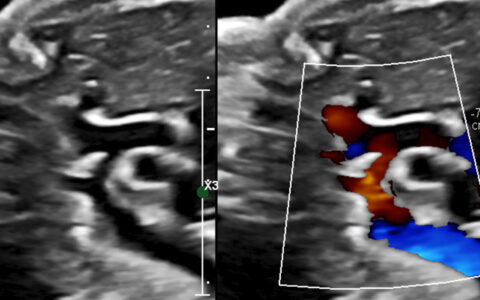Neonatal abstinence syndrome (NAS) rates have more than quintupled in recent years, in part due to rising opioid use during pregnancy. The postnatal withdrawal syndrome now affects more than 32,000 newborns in the U.S. each year—but severity varies widely.
Some newborns experience increased tone and tremors. Others are unable to feed or sleep, and may even require pharmacotherapy or prolonged hospitalization to treat seizures, said Lauren Sanlorenzo, M.D., assistant professor of pediatrics and neonatology at Vanderbilt University Medical Center.
In a recent study published in Hospital Pediatrics, Sanlorenzo and colleagues from Vanderbilt and American University of Beirut explored the influence of benzodiazepine co-exposure on NAS.
“We know that antenatal co-exposure to additional substances, such as tobacco and SSRIs increase NAS incidence,” Sanlorenzo said. “This paper helps understand how co-exposure to additional substances affects disease severity.”
Focus on Benzodiazepines
Opioid misuse and benzodiazepines, such as Valium and Xanax, are commonly connected. The National Institute on Drug Abuse estimates more than 30 percent of opioid overdoses also involve the common class of anti-anxiety medications. Benzodiazepines may not raise concerns for at-risk pregnant women, as the drugs “do not carry a significant teratogenic risk,” according to the American College of Obstetricians and Gynecologists.
The new retrospective cohort study analyzed patient records of 112,029 maternal-infant dyads with 822 cases of NAS (73 percent required treatment and a hospital stay of at least five days). The researchers sought to determine whether benzodiazepine exposure during pregnancy increased risk of severe, pharmacologically-treated NAS.
Increased Risk
Infants exposed to benzodiazepines in utero were more than 50 percent more likely to require medications to treat NAS symptoms, as compared to infants who were not exposed.
While benzodiazepine exposure increased an infant’s risk of developing pharmacologically-treated NAS, other drug exposures did not. The researchers did not find the same severity elevation associated with co-exposure to tobacco, marijuana, cocaine, gabapentin, or SSRIs. The study provides new information about common polypharmacy seen in clinic, Sanlorenzo said.
“If we focus just on opioids, we can overlook other medications that can be risky to both the mother and infant.”
“Our findings reflect the reality that many women who use opioids also use benzodiazepines, which now we know has real implications for the baby, who is more likely to have severe presentation of disease. If we focus just on opioids, we can overlook other medications that can be risky to both the mother and infant.”
Supporting Patients
Pregnant women who take anti-anxiety medications along with an opioid may not realize how dangerous the combination is for their infant. The new study helps confirm that the combination dramatically increases risk of severe NAS.
The authors advise prescribing providers to exercise additional caution when prescribing benzodiazepines for pregnant women, and to warn pregnant women of the risks. They also suggest obtaining a history of antenatal benzodiazepine exposure to inform risk stratification.
Said Sanlorenzo, “As the number of infants with NAS continues to rise, applying what we know about risk prediction to clinical care becomes increasingly important.”





